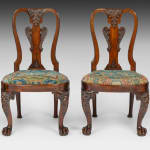Pair of 18th Century Chinese Export Carved Huang Huali Side Chairs
100 x 57 x 42 cm
Provenance
Property from the Estate of Robert K. Johnson of Maine and South Carolina
Chinese export furniture brought together English design with Chinese woods and construction methods. Huang Huali is denser than woods such as walnut and mahogany, used in English-made chairs at this time. The chairs originate from an important group of Huang Huali chairs made in China in the eighteenth century for export to England. They are based on designs produced in England during the late 1730s. An English set of the exact design was owned and advertised by the New York English furniture dealers Devenish. A similar set of two armchairs and four chairs in the Lady Lever Art Gallery is discussed by Lucy Wood. She writes: ‘…the extant ‘Chinese’ chairs of this model appear to come from more than one set. A further thirteen (of possibly fifteen) plain chairs and one armchair are known – four of the plain chairs with recorded Roman numerals, including IIII as on one of the Lady Lever chairs, which implies the creation of at least two sets. Moreover, other examples are known with fixed caned seats, which presumably were made for a third set.’…’It is unusual for the English prototype for Chinese-export furniture to be so clearly identifiable – though another instance occurs with a group of chairs …attributed to Giles Grendey.’ (‘The Upholstered Furniture in the Lady Lever Art Gallery’, Volume I, p.429 - 440). The long set of chairs referred to by Lucy Wood were probably the set sold by Mallett at Masterpiece in 2013 which are now in a private museum in China.
An identical set of chairs feature in a painting of William Gough 1st Bt. (1708-1774) and his family by William Verelst, dated 1741 although it is uncertain whether the chairs are English or Chinese. The Gough family were merchants who traded with India and China, which provides a credible theoretical link between the English and Chinese models. The direct comparison between the English and Chinese chairs of this design can be seen with the two side chairs published in the catalogue of The Gerstenfeld Collection, with the English walnut model on the left and the Chinese one made in rosewood on the right. (Edward Lennox-Boyd ed., Masterpieces of English Furniture: The Gerstenfeld Collection, London, 1998, p. 80, pls. 58-59). Another (English) walnut model can be seen in The Metropolitan Museum of Art. An armchair matching this model was sold at Bonham's London, on 20 November 2013 (lot 47).
Crossman wrote: ‘Perhaps the chairs most directly copied from a known English prototype are two superb side chairs, part of a larger set (and also known in other examples) in the Milhender collection.’ ‘The chairs are the epitome of Chippendale style with their finely carved hairy paw feet, elaborately conceived knees with boldly carved cartouches of lions’ masks, and ornately designed backs with splats. Since identical English chairs are known, it is possible the Chinese versions were copied either from a design or a chair which had made its way to the Orient.’ (‘The Decorative Arts of the China Trade’ p. 231-233)
Lucy Wood suggests that this model of chair may have been en-suite with a harlequin table. (Lucy Wood, The Upholstered Furniture in the Lady Lever Art Gallery, p.437, figs. 325 and 326).




